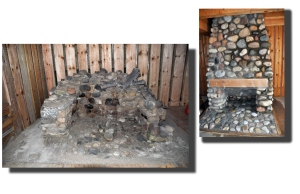
The ongoing reconstruction of the South Southwest Rowhouse at Colonial Michilimackinac is an impressive undertaking. It’s the largest in the site’s history, the first in more than two decades, and when completed, will house two new exhibits.
One of the featured components of the new exhibit “France at Mackinac” are the ruins of the original fireplace from the structure constructed more than 250 years ago. This particular fireplace is one of the few remaining structures left standing after British soldiers demolished the fort in 1780-81. As part of one of the longest ongoing archaeological digs in North America, the remnants of the rowhouse and the fireplace were carefully excavated over a number of years from 1963 to 2007. Stone fireplaces such as this were found in nearly every house at Michilimackinac, but this is the only one that remains because it was covered and preserved in a hill of sand soon after the demolition.
Located in the west side of the building, the structure of this fireplace ruin served as a model for Tom Smith and his crew from Ground Level Masonry to create a similar fireplace on the east end of the building, showing how the stone hearth would have looked when originally built around 1750.









